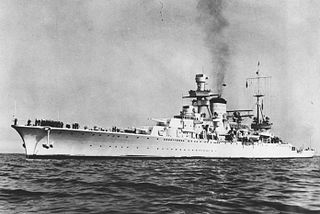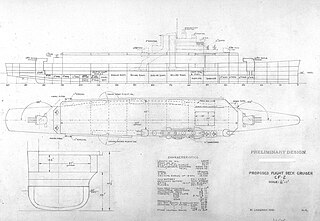
A heavy cruiser was a type of cruiser, a naval warship designed for long range and high speed, armed generally with naval guns of roughly 203 mm (8 inches) in calibre, whose design parameters were dictated by the Washington Naval Treaty of 1922 and the London Naval Treaty of 1930.

The Pensacola class was a class of United States Navy heavy cruiser, the first "treaty cruisers" designed under the limitations set by the Washington Naval Treaty, which limited cruisers to a maximum of 10,000 long tons (10,160 t) displacement and a maximum main battery caliber of 8-inch (203 mm).

The New Orleans-class cruisers were a class of seven heavy cruisers built for the United States Navy (USN) in the 1930s.

The Renown class consisted of two battlecruisers built during the First World War for the Royal Navy. They were originally laid down as improved versions of the Revenge-class battleships, but their construction was suspended on the outbreak of war on the grounds they would not be ready in a timely manner. Admiral Lord Fisher, upon becoming First Sea Lord, gained approval to restart their construction as battlecruisers that could be built and enter service quickly. The Director of Naval Construction (DNC), Eustace Tennyson-D'Eyncourt, quickly produced an entirely new design to meet Admiral Lord Fisher's requirements and the builders agreed to deliver the ships in 15 months. They did not quite meet that ambitious goal, but they were delivered a few months after the Battle of Jutland in 1916. They were the world's fastest capital ships upon their commissioning.

The York class was the second and final class of heavy cruisers built for the Royal Navy under the terms of the 1922 Washington Naval Treaty. They were essentially a reduced version of the preceding County class, scaled down to enable more cruisers to be built from the limited defence budgets of the late 1920s.

The Baltimore-class heavy cruisers were a large class of heavy cruisers in the United States Navy commissioned during and shortly after World War II. Fourteen Baltimores were completed, more than any other class of heavy cruiser, along with three ships of the Oregon City sub-class. The Baltimores also were the first cruisers in the US Navy to be designed without the limitations of the London Naval Treaty.

The Atlanta-class cruisers were eight United States Navy light cruisers which were designed as fast scout cruisers or flotilla leaders but which proved to be effective anti-aircraft cruisers during World War II. They were also known as the Atlanta-Oakland class. The Atlanta class originally had 16 x 5-inch (127 mm)/38 caliber guns in eight two-gun turrets, arranged with three superfiring turrets forward, three more superfiring aft and two waist mounts, one port and one starboard, giving the first four Atlanta-class cruisers the heaviest anti-aircraft armament of any cruiser of World War II. The last four ships of the class, starting with Oakland, had a slightly revised armament with a reduced main gun battery - the waist turrets being deleted - as they were further optimized for anti-aircraft fire in light of war experience.

The Courageous class consisted of three battlecruisers known as "large light cruisers" built for the Royal Navy during the First World War. The class was nominally designed to support the Baltic Project, a plan by Admiral of the Fleet Lord Fisher that was intended to land troops on the German Baltic Coast. Ships of this class were fast but very lightly armoured, with only a few heavy guns. They were given a shallow draught, in part to allow them to operate in the shallow waters of the Baltic but also reflecting experience gained earlier in the war. To maximize their speed, the Courageous-class battlecruisers were the first capital ships of the Royal Navy to use geared steam turbines and small-tube boilers.

The Portland class of heavy cruisers was a class of ships designed and constructed by the United States Navy in 1930. The two ships of the class, Portland and Indianapolis, saw extensive service during the Pacific War in World War II.

The Arethusa class was a class of four light cruisers built for the Royal Navy between 1933 and 1937 and that served in World War II. It had been intended to construct six ships, but the last pair, Polyphemus and Minotaur, were ordered in 1934 as the 9,100-ton Town-class Southampton and Newcastle.

The Mogami class (最上型) was a ship class of four cruisers built for the Imperial Japanese Navy (IJN) during the 1930s. They were initially classified as light cruisers under the weight and armament restrictions of the London Naval Treaty. After Japan abrogated that agreement, all four ships were rearmed with larger guns and reclassified as heavy cruisers. All participated in World War II and were sunk.

The Hawkins class consisted of five heavy cruisers built for the Royal Navy during the First World War, although none of them saw service during the war. The first ship to be completed, HMS Vindictive, was renamed from HMS Cavendish and converted into an aircraft carrier while under construction. All ships were named after Elizabethan sea captains. The three ships remaining as cruisers in 1939 served in the Second World War, with Effingham being an early war loss through wreck; Raleigh had been lost in a similar shipwreck on uncharted rocks in 1922. Vindictive, though no longer a cruiser, also served throughout the War. This class formed the basis for the definition of the maximum cruiser type under the Washington Naval Treaty of 1922.

HMS Vindictive was a warship built during the First World War for the Royal Navy (RN). Originally designed as a Hawkins-class heavy cruiser and laid down under the name Cavendish, she was converted into an aircraft carrier while still being built. Renamed in 1918, she was completed a few weeks before the end of the war and saw no active service with the Grand Fleet. The following year she participated in the British campaign in the Baltic against the Bolsheviks, during which her aircraft made numerous attacks against the naval base at Kronstadt. Vindictive returned home at the end of the year and was placed in reserve for several years before her flight decks were removed and she was reconverted back into a cruiser. The ship retained her aircraft hangar and conducted trials with an aircraft catapult before she was sent to the China Station in 1926. A year after her return in 1928, she was again placed in reserve.

The two Veinticinco de Mayo-class heavy cruisers served in the Argentine Navy through World War II. They were the only post-Washington Naval Treaty heavy cruisers built for a South American navy. Both ships of the class were built in Italy by the OTO company, and commissioned into the Argentine Navy in 1931.

The Suffren class was an interwar treaty cruiser built by France for the French Navy. The design was based on the preceding Duquesne-class cruiser and traded speed for protection while retaining the same armament. The first ship, Suffren, was completed based on this design. The following ships, Colbert, Foch, Dupleix, were completed to a modified design with heavier secondary armament and rearranged topside. The ships entered service from 1930 to 1933, with Suffren being the sole survivor of the Second World War.

The Duquesne-class cruiser was a group of two heavy cruisers built for the French Navy in the mid 1920s, the first such vessels built for the French fleet. The two ships in the class were the Duquesne and Tourville.

The Aoba-class cruisers were a class of two heavy cruisers constructed for the Imperial Japanese Navy (IJN) which saw service during World War II.

The Myōkō-class cruisers were a series of four heavy cruisers built for the Imperial Japanese Navy in the late 1920s. Three were lost during World War II.

The flight-deck cruiser was a proposed type of aircraft cruiser,, designed by the United States Navy during the Interwar period. Several designs were proposed for the type, but none was approved for construction. The final design was developed just before World War II, and the entry of the United States into the war saw the project come to an end.
The Neptune class was a proposed class of cruisers planned for the British Royal Navy in the latter years of the Second World War. They were large ships which were to be armed with twelve 6-inch (152 mm) dual-purpose guns and with a heavy secondary armament. Although five ships of the class were planned in 1944, they were cancelled following the end of the war and before construction could begin.



















